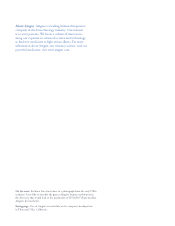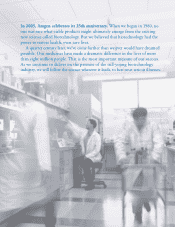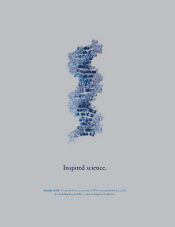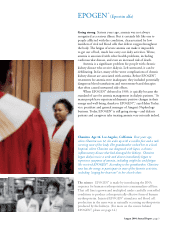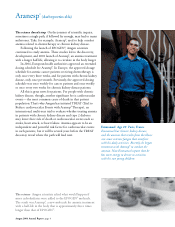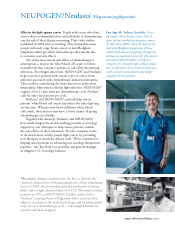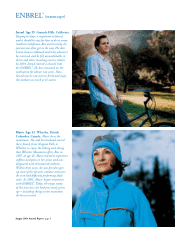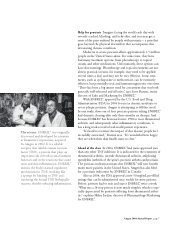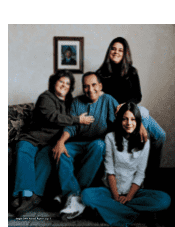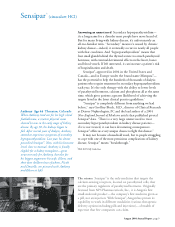Amgen 2004 Annual Report Download - page 7
Download and view the complete annual report
Please find page 7 of the 2004 Amgen annual report below. You can navigate through the pages in the report by either clicking on the pages listed below, or by using the keyword search tool below to find specific information within the annual report.
Allies in the fi ght against cancer People with cancer who don’t
receive their recommended doses and schedules of chemotherapy
run the risk of their disease worsening. That’s why studies
published in 2004 were so startling: They found that many
people with early-stage breast cancer or non-Hodgkin’s
lymphoma didn’t get all the chemotherapy they should, due
to concerns over side effects.
One of the most serious side effects of chemotherapy is
neutropenia, a drop in the white blood cell count to below-
normal levels that can place patients at risk of life-threatening
infections. Two Amgen discoveries, NEUPOGEN®
and Neulasta®
,
help to protect patients with certain types of cancer from
infection associated with chemotherapy-induced neutropenia.
They work by stimulating the bone marrow to make more
neutrophils, white blood cells that fi ght infection. NEUPOGEN®
requires 10 or 11 injections per chemotherapy cycle; Neulasta®
calls for only one injection per cycle.
Neulasta® and NEUPOGEN®
can both help restore
patients’ white blood cell counts and reduce the risk of getting
an infection. When patients have suffi cient white blood
cell counts, their doctors may have a better chance of giving
chemotherapy on schedule.
Together with Aranesp®
, Neulasta® and NEUPOGEN®
have made Amgen the world’s leading provider of oncology
supportive care (therapies to help cancer patients combat
the side effects of their treatment). But the company wants
to do much more to help people fi ght cancer by providing
new therapies to attack the disease itself. “We’re committed to
helping cancer patients by advancing our oncology therapeutics
pipeline,” says Jim Daly, vice president and general manager
of Amgen’s U.S. Oncology business.
The science Amgen scientists were the fi rst to describe the
chemical characteristics of human granulocyte colony-stimulating
factor (G-CSF), the protein that spurs the production of neutro-
phils, and to begin clinical studies of G-CSF. The results reached
patients in 1991 as NEUPOGEN®
. Further studies led to
Neulasta®
, a unique form of Filgrastim with a structure that
allows it to remain in the body much longer and be administered
only once per chemotherapy cycle
—
a meaningful benefi t for
patients and their caregivers.
Lea Age 40 Sydney, Australia Lea is
passionate about being a nurse. For 15
years she has worked in emergency rooms.
In November 2002, when she learned she
had non-Hodgkin’s lymphoma, all Lea
could think about was getting through her
treatments and back to her life. Her doctors
prescribed NEUPOGEN ®
to help her
complete her chemotherapy without delays
due to infections. Lea is back at work now,
with a greater commitment and deeper
empathy for her patients.
NEUPOGEN®
/Neulasta®(Filgrastim/pegfilgrastim)
Amgen 2004 Annual Report page 5


